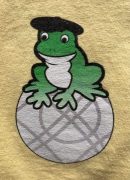Les Boulefrogs History
In early 2005 twelve Church Hill residents responded to an article in the Church Hill Association Newsletter and met in Patrick Henry Park to learn about the game of pétanque. That was just the beginning. Les Boulefrogs of Church Hill Pétanque Club celebrated its tenth anniversary 2016. Looking for a suitable terrain on which to play, the club found that some of the gravel alleys in the area were similar to the terrains in Europe – pétanque can be played on just about any patch of land that is relatively flat.
Through word-of-mouth the club grew in membership and with the support of the Richmond Department of Parks, Recreation and Community Facilities (PRCF) the club members moved out of the alleys and built two courts in Chimborazo Playground in 2006. An article in the Richmond Times-Dispatch resulted in more interest in the game, especially by those with a French connection through travel or education. Les Boulefrogs joined the Federation of Pétanque USA (FPUSA) in 2006.
The club now has many members from age 16 to 75 and from all over greater Richmond – from Colonial Heights to as far as Fredericksburg. Due to the diverse geographic expansion of its members, the name was changed to Les Boulefrogs Petanque Club of Virginia in 2021.
Petanque History
The ancient Greeks are recorded to have played a game called spheristics, by throwing a round stone ball as far as possible, as early as the 6th century B.C. The Ancient Romans modified the game by adding a target that had to be approached as closely as possible. This variation was brought to the Provence region of France by the Romans.
After arriving in France the stone balls were replaced by wooden balls, nails were driven in them to give them greater weight. The game became commonly known as “boules” and it was played throughout Europe. By the 19th century, in England the sport had become known as “bowls” or “lawn bowling”; but in France it was always known as “boules” and was played throughout the country. In the south of France it had evolved into what was called “jeu provençal” similar to today’s pétanque except that the field was larger and players ran 3 steps before throwing the ball. The game was played in villages all over Provence, usually in town squares where the soil was compacted and there were plenty of shade trees.
Pétanque in its present form was transformed in 1907 in the town of La Ciotat near Marseilles by a French boule lyonnaise player named Jules Lenoir. This gentleman was plagued with rheumatism that prevented him from running before he threw the ball. His idea was to reduce the length of the playing field to 14 X 50 ft. [4 X 15 meters] which is about half the size of the “jeu provençal” terrain and the moving delivery was replaced with a stationary one.
The first pétanque tournament with the new rules was organized in 1910 by the Pitiot brothers, who were proprietors of a café at La Ciotat. After that tournament the sport grew with great speed and soon it became the most popular form of “boules” in France.
The casual form of the game is played during summer vacations by an estimated 17 million people in France. The International Pétanque Federation was founded in 1958 in Marseille and now claims more than 600,000 members in 52 countries. In recent years pétanque clubs have sprung up in cities throughout the United States. The Federation of Pétanque USA has become a national ruling body for the sport here in the United States.
